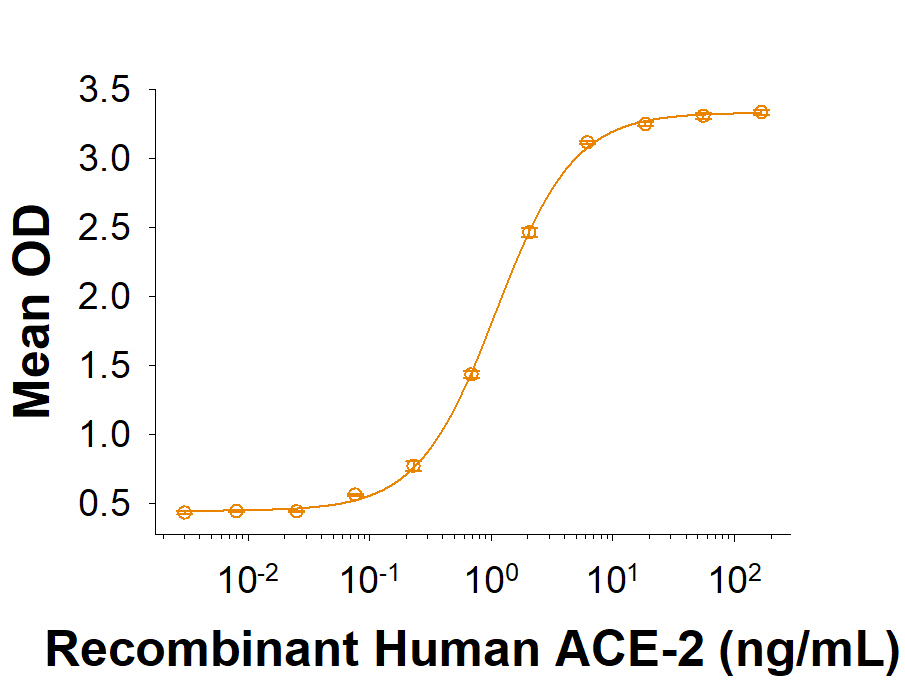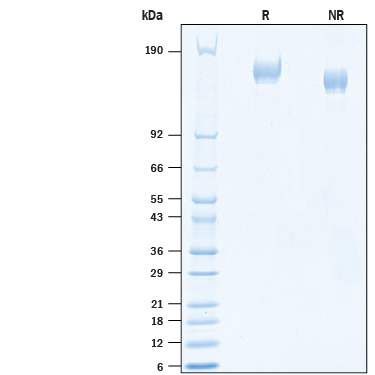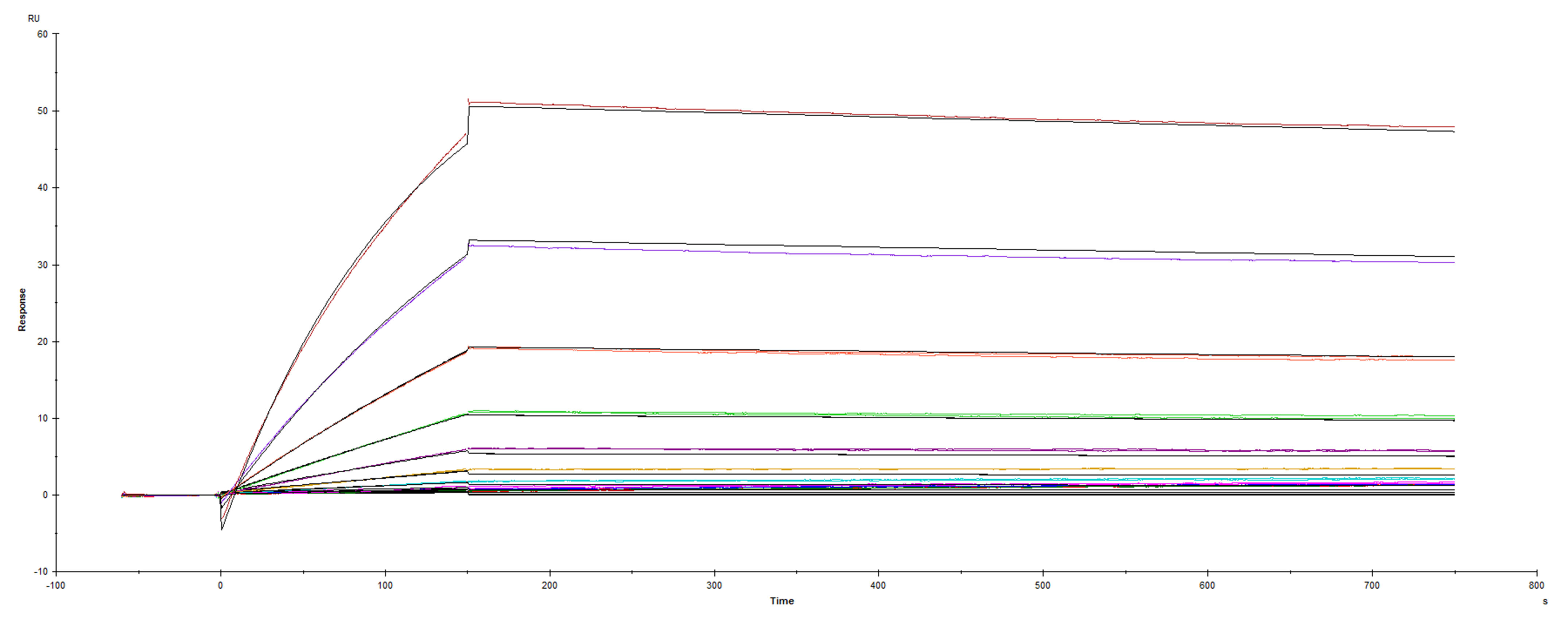Recombinant SARS-CoV-2 B.1.1.7 Spike GCN4-IZ His Protein, CF
Recombinant SARS-CoV-2 B.1.1.7 Spike GCN4-IZ His Protein, CF Summary
Product Specifications
| SARS-CoV-2 B.1.1.7 Spike (Val16-Lys1211)(His69del, Val70del, Tyr145del, Asn501Tyr, Ala570Asp, Asp614Gly, Pro681His, Thr716Iso, Ser982Ala, Asp1118His)(Arg682Ser, Arg685Ser, Lys986Pro, Val987Pro) Accession # YP_009724390.1 | GCN4-IZ | 6-His tag | N-terminus | C-terminus |
Analysis
Product Datasheets
Carrier Free
CF stands for Carrier Free (CF). We typically add Bovine Serum Albumin (BSA) as a carrier protein to our recombinant proteins. Adding a carrier protein enhances protein stability, increases shelf-life, and allows the recombinant protein to be stored at a more dilute concentration. The carrier free version does not contain BSA.
In general, we advise purchasing the recombinant protein with BSA for use in cell or tissue culture, or as an ELISA standard. In contrast, the carrier free protein is recommended for applications, in which the presence of BSA could interfere.
10796-CV
| Formulation | Lyophilized from a 0.2 μm filtered solution in PBS with Trehalose. |
| Reconstitution | Reconstitute at 500 μg/mL in PBS. |
| Shipping | The product is shipped at ambient temperature. Upon receipt, store it immediately at the temperature recommended below. |
| Stability & Storage: | Use a manual defrost freezer and avoid repeated freeze-thaw cycles.
|
Scientific Data
 View Larger
View Larger
Recombinant SARS-CoV-2 B.1.1.7 Spike (GCN4-IZ) His-tag (Catalog # 10796-CV) binds Recombinant Human ACE-2 His-tag (933-ZN) in a functional ELISA.
 View Larger
View Larger
2 μg/lane of Recombinant SARS-CoV-2 B.1.1.7 Spike GCN4-IZ His-tag (Catalog # 10796-CV) was resolved with SDS-PAGE under reducing (R) and non-reducing (NR) conditions and visualized by Coomassie® Blue staining, showing bands at 140-170 kDa.
 View Larger
View Larger
Recombinant SARS-CoV-2 B.1.1.7 (UK Variant) Spike protein (GCN4-IZ) His-tag was immobilized on a Biacore Sensor Chip CM5, and binding to recombinant human ACE-2 (933-ZN) was measured at a concentration range between 0.046 nM and 47.2 nM. The double-referenced sensorgram was fit to a 1:1 binding model to determine the binding kinetics and affinity, with an affinity constant of KD=0.6131 nM. (Biacore T200).
Reconstitution Calculator
Background: Spike
SARS-CoV-2, which causes the global pandemic coronavirus disease 2019 (Covid-19), belongs to a family of viruses known as coronaviruses that also include MERS-CoV and SARS-CoV-1. Coronaviruses are commonly comprised of four structural proteins: Spike protein (S), Envelope protein (E), Membrane protein (M) and Nucleocapsid protein (N) (1). The SARS-CoV-2 S protein is a glycoprotein that mediates membrane fusion and viral entry. The S protein is homotrimeric, with each ~180-kDa monomer consisting of two subunits, S1 and S2 (2). In SARS-CoV-2, as with most coronaviruses, proteolytic cleavage of the S protein into S1 and S2 subunits is required for activation. The S1 subunit is focused on attachment of the protein to the host receptor while the S2 subunit is involved with cell fusion (3-5). The S protein of SARS-CoV-2 shares 75% and 29% amino acid sequence identity with S protein of SARS-CoV-1 and MERS, respectively. The S Protein of the SARS-CoV-2 virus, like the SARS-CoV-1 counterpart, binds a metallopeptidase, Angiotensin-Converting Enzyme 2 (ACE-2), but with much higher affinity and faster binding kinetics through the receptor binding domain (RBD) located in the C-terminal region of S1 subunit (6). It has been demonstrated that the S Protein can invade host cells through the CD147/EMMPRIN receptor and mediate membrane fusion (7, 8). Polyclonal antibodies to the RBD of the SARS-CoV-2 protein have been shown to inhibit interaction with the ACE-2 receptor, confirming RBD as an attractive target for vaccinations or antiviral therapy (9). There is also promising work showing that the RBD may be used to detect presence of neutralizing antibodies present in a patient's bloodstream, consistent with developed immunity after exposure to the SARS-CoV-2 (10). Several emerging SARS-CoV-2 genomes have been identified including the B 1.1.7 (United Kingdom) variant (11). The B 1.1.7 variant contains 1 significant mutation of interest in the RBD domain, N501Y, which has been shown to result in enhanced binding affinity for hACE-2 (12). Further, the B 1.1.7 variant appears to more easily transmissible, exhibit increased viral loads and, potentially, be associated with higher mortality rates compared to preexisting variants (11, 13).
- Wu, F. et al. (2020) Nature 579:265.
- Tortorici, M.A. and D. Veesler (2019) Adv. Virus Res. 105:93.
- Bosch, B.J. et al. (2003). J. Virol. 77:8801.
- Belouzard, S. et al. (2009) Proc. Natl. Acad. Sci. 106:5871.
- Millet, J.K. and G.R. Whittaker (2015) Virus Res. 202:120.
- Ortega, J.T. et al. (2020) EXCLI J. 19:410.
- Wang, K. et al. (2020) bioRxiv https://www.biorxiv.org/content/10.1101/2020.03.14.988345v1.
- Isabel, et al. (2020) Sci Rep 10, 14031. https://doi.org/10.1038/s41598-020-70827-z.
- Tai, W. et al. (2020) Cell. Mol. Immunol. https://doi.org/10.1016/j.it.2020.03.007.1.
- Okba, N.M.A. et al. (2020) Emerg. Infect. Dis. https://doi.org/10.3201/eid2607.200841.
- Kidd, M. et al. (2021) The Journal of Infectious Diseases https://doi.org/10.1093/infdis/jiab082.
- Zahradník, J. et al. (2021) bioRxiv https://doi.org/10.1101/2021.01.06.425392.
- Davies, N.G. (2020) medRxiv doi:10.1101/2020.12.24.20248822.
Citations for Recombinant SARS-CoV-2 B.1.1.7 Spike GCN4-IZ His Protein, CF
R&D Systems personnel manually curate a database that contains references using R&D Systems products. The data collected includes not only links to publications in PubMed, but also provides information about sample types, species, and experimental conditions.
2
Citations: Showing 1 - 2
Filter your results:
Filter by:
-
Site specific N- and O-glycosylation mapping of the spike proteins of SARS-CoV-2 variants of concern
Authors: Shajahan, A;Pepi, LE;Kumar, B;Murray, NB;Azadi, P;
Scientific reports
-
Site Specific N- and O-glycosylation mapping of the Spike Proteins of SARS-CoV-2 Variants of Concern
Authors: A Shajahan, L Pepi, B Kumar, N Murray, P Azadi
Research square, 2022-11-16;0(0):.
Species: Human
Sample Types: Recombinant Protein
Applications: Bioassay
FAQs
-
What is the significance of the Arg682Ser, Arg685Ser and Lys986Pro, Val987Pro mutations in Recombinant SARS-CoV-2 B.1.1.7 Spike GCN4-IZ His Protein, CF (Catalog # 10796-CV)?
Furin cleavage resistance is conferred by the Arg682Ser and Arg685Ser mutations. The mutations Lys986Pro and Val987Pro stabilize and promote the prefusion conformation of this Spike protein.
Reviews for Recombinant SARS-CoV-2 B.1.1.7 Spike GCN4-IZ His Protein, CF
Average Rating: 5 (Based on 1 Review)
Have you used Recombinant SARS-CoV-2 B.1.1.7 Spike GCN4-IZ His Protein, CF?
Submit a review and receive an Amazon gift card.
$25/€18/£15/$25CAN/¥75 Yuan/¥2500 Yen for a review with an image
$10/€7/£6/$10 CAD/¥70 Yuan/¥1110 Yen for a review without an image
Filter by:

